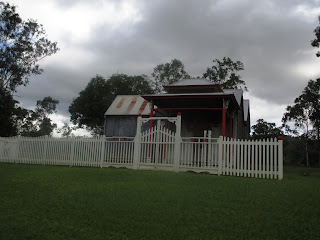After our Coffee Works adventure, we went to the MareebaHeritage and Information Centre which
was just around the corner from the Coffee place. Mareeba is a small country
town with lots of natural attractions such as wetlands, coffee plantations and
boutique shops and cafes. The museum is free and is about the local history of
the area.
 |
| source |
Mareeba use to be a place where Tobacco was grown which was
the main source of income for the community.
It was a tobacco town from the late 1920 to 2003 when the government
banned the growing of Tobacco in Australia. I think the coffee plantations replaced the
tobacco farms but I suppose it must have been tough for the town to lose that
income initially.
Also, on display at the museum was the ambulance railway
train which serviced Mareeba and the neighbouring towns. The train was
particularly useful during the wet season when the roads are closed due to
flooding.
There were also displays from colonial times as well as
honouring the Muluridji tribe who
were the original inhabitants of the land.
I thought the museum was pretty good for a small community
museum. It was a little rundown and a little dusty but I think a bit of a clean
and new paint job would spruce the place up.
As the museum is also a tourist information centre, there
were lots of free maps and brochures about the local attractions. We found out
that there use to be a China Town in the neighbouring town of Atherton so we
decided to go there next.
Many people assume that most non white Australians are fresh
off the boat but some have been in Australia for generations. The first wave of
immigrants arrived during the 18th century during the gold rush.
Paul and I went to the Hou Wang Miau temple in Atherton which is the only remaining
structure of China Town left.
The Chinese arrived in Atherton for gold mining. They were
treated poorly and overworked and underpaid. They also did the most difficult
and dangerous jobs. Others grew crops and others became timber cutters.
I felt a little sad learning about the history of the Chinese
immigrants. They worked very hard but faced racial discrimination. Most of the
Chinese left after World War 1, when the government reclaimed the farm lands
for returning veterans. So, China Town was scrapped and torn down after that.
 |
| an old picture of China Town |
The temple remained as it was looked after the remaining
people. The temple was in use until the 1970s then it was deserted and used as
play house by the local children. Restoration began in the 1980s and the museum
was made alongside it.
 |
| The temple |
The temple is made from tin and timber which was what the
Chinese immigrants could afford at the time.
The entrance is made on raised levels which the guide explained was to
ward off evil spirit because they can only travel in a straight line.
I thought the interior of the temple would contain a few
pews but I was surprised to find an altar and a heavenly well. Every part of
the temple represented something from the Taoist religion. There was also a caretaker room and storeroom
attached to the temple.
The rest of China Town was just grassland with little
monuments to represents the buildings that use to be there.
During the tour, there was a young man who spoke only to
Paul. He would follow us around the
exhibits and tell Paul things he observed and gave tips on local travel
destinations. We weren't sure whether he was just being nice, or he was lonely
or looking for love. Paul was bemused by the experience.





No comments:
Post a Comment
We absolutely love comments but please don't comment just to advertise your giveaways or ask us to follow you, such comments will be deleted.